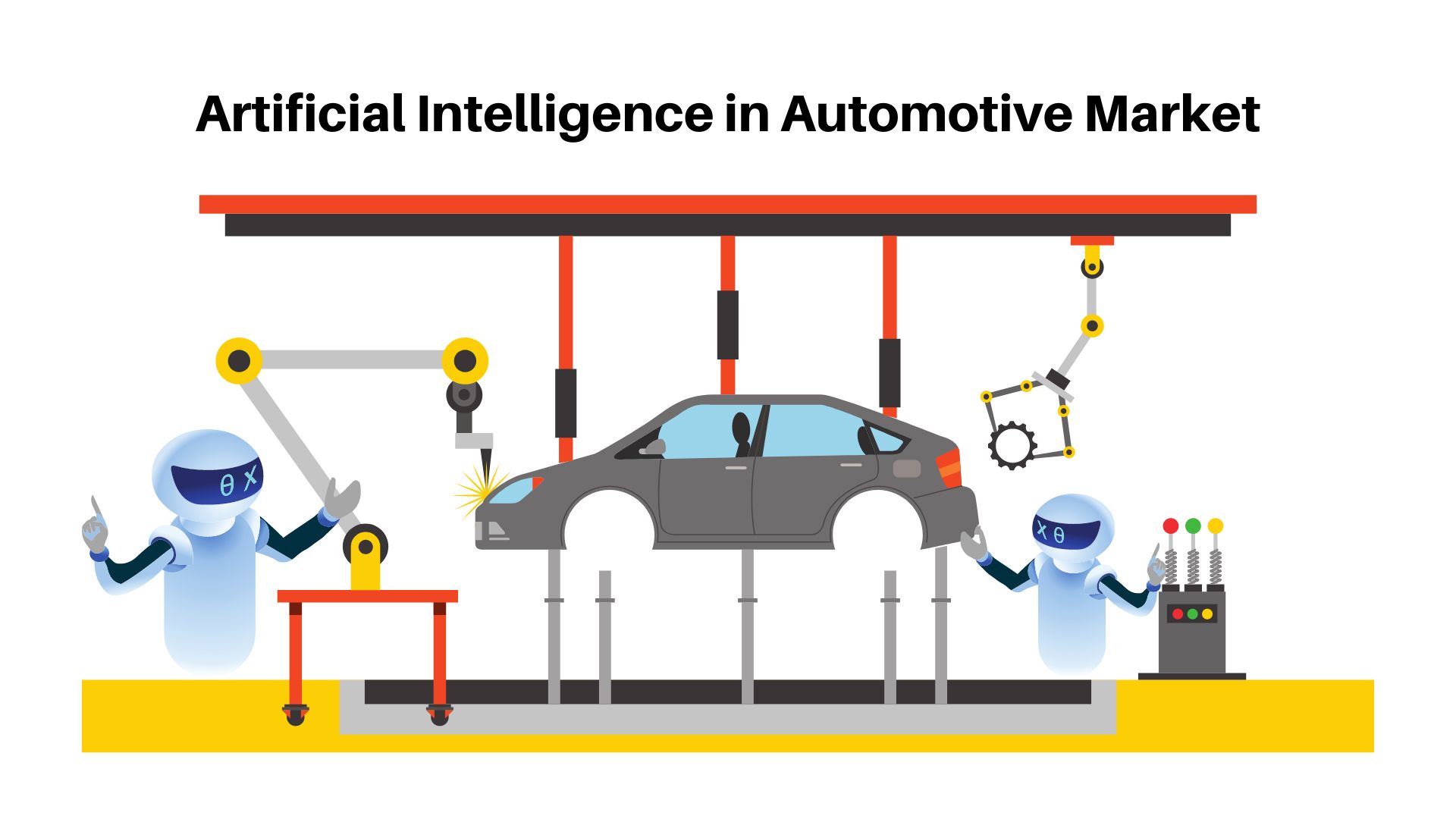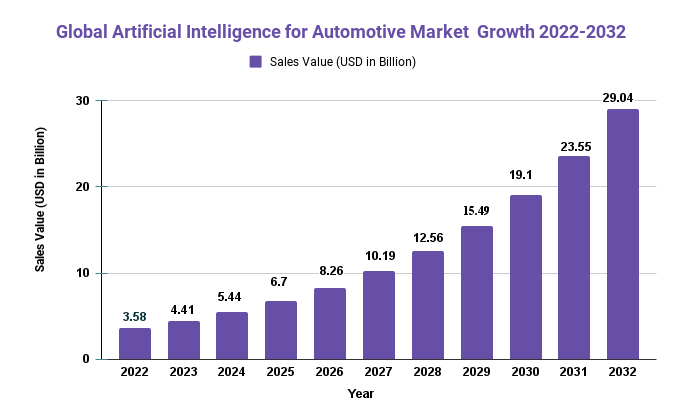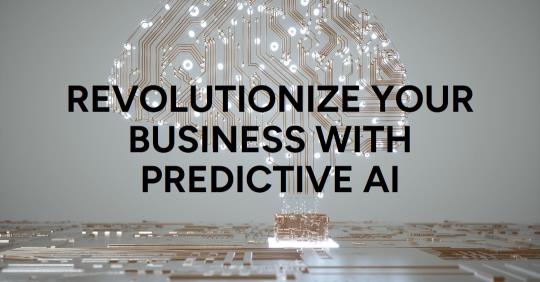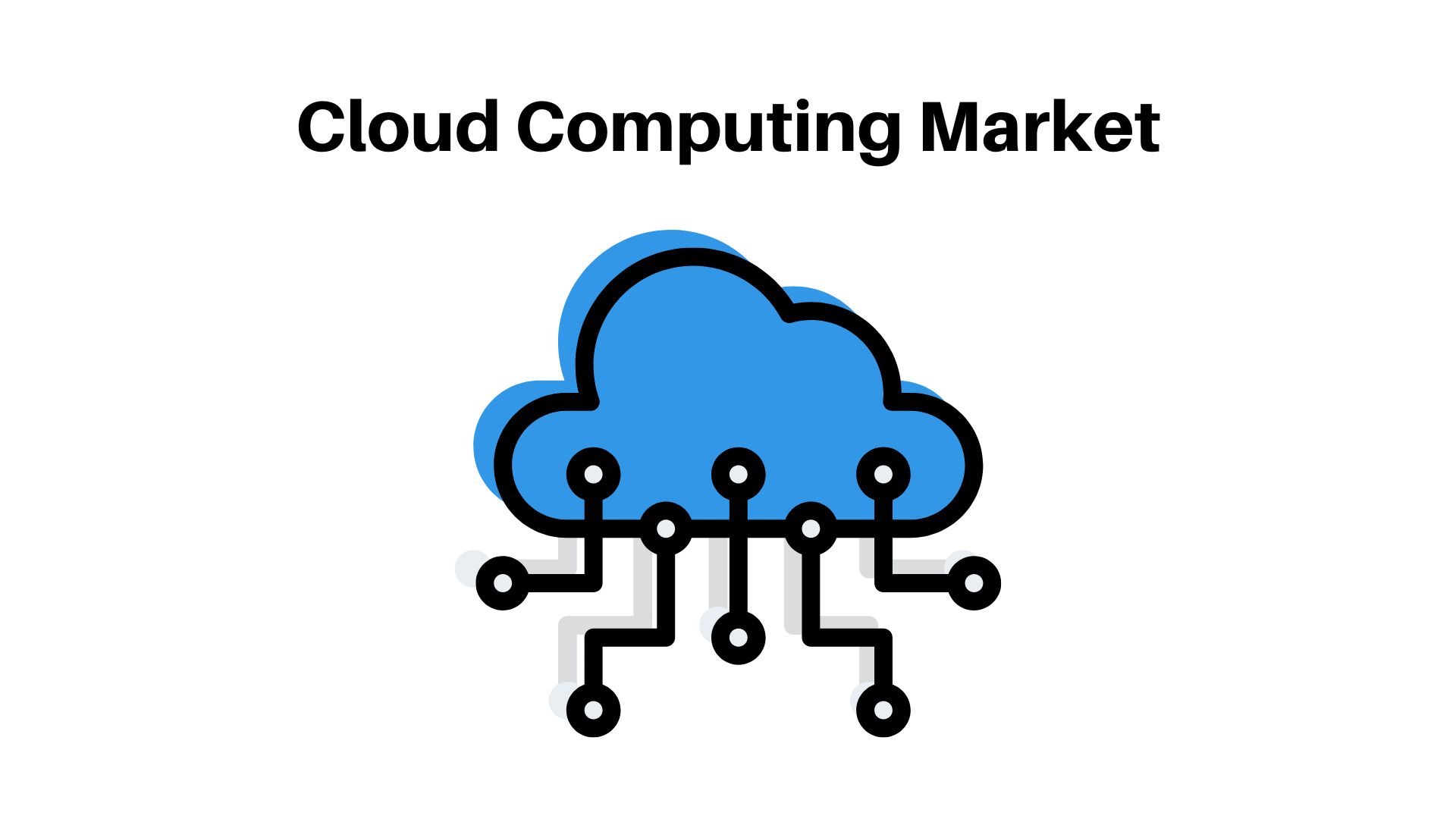Artificial Intelligence in Automotive Market Size will Observe Substantial Growth by 2032 with a CAGR of 23.3%

Page Contents
Market Overview
Published Via 11Press: By 2032, the Global Artificial Intelligence in Automotive Market size is expected to be worth USD 29.04 Bn, rising from its current value of USD 3.58 Bn in 2022 at a compound annual growth rate (CAGR) of 23.3% from 2023 -2032.
Artificial Intelligence (AI) for the Automotive market is a rapidly rising sector that is revolutionizing the auto industry. AI technology is being employed to enhance driving experiences, automate tasks, and boost vehicle safety. With AI being integrated into automotive production lines, we're seeing self-driving cars, advanced driver assistance systems (ADAS), and intelligent infotainment systems being developed at an unprecedented rate. Globally, this market is projected to experience significant compound annual growth during 2023-2032.
The key factors driving growth in the AI for Automotive market include increasing demand for advanced driver assistance systems (ADAS) and self-driving cars, rising need for fuel-efficient and emission-free vehicles, rising preference for connected cars with intelligent infotainment systems, as well as technological advances in AI and machine learning.
However, the high cost of AI-powered automotive systems, lack of skilled professionals, privacy and cybersecurity concerns, lack of standardization and regulatory framework for AI in the automotive industry and limited infrastructure for charging electric vehicles in some regions could hinder growth in this market.
Drivers, trends, and challenges have an impact on market dynamics, which can impact businesses. Request for PDF sample report
Autonomous technology is experiencing a meteoric rise in popularity due to increased consumer awareness. Major automobile companies consider AI technology essential for designing and manufacturing self-driving cars, while numerous governments around the world have taken numerous strategic initiatives to promote innovation within this space.
Advance Driver Assist System (ADAS) level 2 technology is becoming more and more commonplace. AI is being utilized in the automotive industry due to an increasing need for ADAS systems that assist human drivers in making intelligent driving decisions. Automotive manufacturers are adopting AI technology in order to increase productivity and production capacity. As a result, there are plenty of opportunities for startups and industry players to benefit from this growing demand for AI in automotive.

Key Takeaways
- The artificial intelligence in automotive market grew to USD 3.58 Billion in 2022.
- Forecasted compound annual growth rates between 2022 and 2032 is 23.3%.
- By 2032, the artificial intelligence in automotive market is projected to reach USD 29.04 Billion.
- The global Artificial Intelligence in automotive market is projected to experience a robust compound annual growth rate over the forecast period.
- The introduction of AI into the automotive industry has enabled the creation of self-driving cars, advanced driver assistance systems (ADAS) and sophisticated infotainment systems.
- Alphabet Inc., Audi AG, BMW AG, General Motors Company, Intel Corporation, Microsoft Corporation, NVIDIA Corporation, Tesla Inc., Toyota Motor Corporation and Uber Technologies Inc are some of the prominent players in this market.
Regional Snapshot
- North America is expected to be the leading contributor to the automotive artificial intelligence market throughout the forecast period. This trend is likely to continue.
- The rapid advancements in autonomous vehicle technology and stringent regulations for road safety will spur an increase in automotive artificial intelligence. North America boasts some of the world's premier technological companies, enabling early adoption and introduction of new technologies such as automotive artificial intelligence.
- Government funding and incentives have played a major role in developing this technology, which is heavily used by the automotive industry in the US. The “Big Three” – Ford Motor Company, General Motors and Fiat-Chrysler Automotive-are continuously upgrading their product lineups. The US boasts advanced features like adaptive cruise control and lane departure warning systems as well as voice recognition system, gesture recognition blind spot detection voice recognition voice recognition voice recognition voice recognition all combined into one comprehensive package.
Drivers
- Safety: AI technology is one of the major driving forces in the automotive market. Features like collision avoidance, lane departure warning and automatic emergency braking are becoming more and more commonplace, helping reduce accidents and save lives.
- Efficiency: AI can be utilized to optimize vehicle performance and boost fuel economy, which is becoming increasingly crucial as environmental concerns continue to escalate.
- Personalization: Customers are increasingly demanding personalized features and experiences, which AI can help provide through capabilities such as voice recognition, driver behavior analysis, and personalized in-car settings.
- Connectivity: The growth of connected cars is another important driver for AI in the automotive market. AI-enabled features like predictive maintenance, remote diagnostics, and over-the-air software updates are becoming more essential for these connected automobiles.
- Autonomous Driving: The development of self-driving cars is a major driver for AI in the automotive market. Autonomous driving technology holds great promise to reduce accidents, provide mobility to those unable to drive themselves, and reduce traffic congestion.
- Cost Savings: AI can be employed to optimize supply chains and logistics, reduce downtime and repair expenses through predictive maintenance, and enhance overall efficiency – leading to cost-savings for manufacturers as well as consumers alike.
The automotive industry has experienced a marked improvement in the user-friendliness and functionality of human-machine interface (HMI) solutions. These programs enable customers to manage applications like music, vehicle lights, and infotainment more efficiently and conveniently than ever before.
Historically, the electronics system in a vehicle only contributed to 1-2% of overall costs. But with increasing consumer demands for improved user experiences, this share has now reached 8-12%.
Driver assistance technology is an increasingly common feature of modern vehicles, heavily dependent on AI. The car's AI system can detect if a driver is tired or sleepy just by looking into their eyes. Furthermore, it collects information about the driver to make commutes more pleasant, simpler, and less stressful – including their preferred settings for temperature, music, and destinations. Software developers collaborate closely with automotive companies to ensure AI creates the ideal interior environment for drivers; this results in engaging user experiences.
Grow your profit margin with Market.us – Acquire this Report
Restraints
- Data Privacy and Security: As connected cars become more intelligent, security concerns have arisen about the security and privacy of data collected and shared. This includes personal details such as location, driving habits, biometric data – which could be vulnerable to hacking or cyber attacks.
- Liability and legal Issues: As AI technology progresses, there is an urgent need to address legal and liability matters associated with accidents involving autonomous vehicles. Who bears responsibility for accidents caused by self-driving cars? How can liability be established when an AI system malfunctions?
- Ethical Considerations: AI algorithms may be biased or discriminate against certain groups of people, leading to ethical concerns. For instance, facial recognition software could have a higher error rate for those with darker skin tones, potentially leading to potential harm or discrimination against them.
- Technical Limitations: Although AI technology is progressing quickly, there are still technical issues to address, such as being able to operate in extreme weather conditions or navigating complex urban settings.
- Cost: Constructing and installing AI systems in vehicles can be expensive, which may limit their adoption.
Commercializing technology systems will drive up the price of autonomous vehicles. At present, most advanced features are only found in luxury and premium cars due to their limited customer base and high prices.
Market growth will be hindered by the high cost of vehicles. As opposed to semi-autonomous cars, demand for autonomous cars will be lower. To enable autonomous driving technology to work effectively, infrastructure such as lane assist technology requires lane lines along the roadside in order for it to detect and adjust your position; this requires additional development costs in this area.
Vehicles equipped with advanced features, such as blind spot detection (BSD), Lane departure warning (LDW), adaptive Cruise Control (ACC), forward collision warning system(FCWS), etc., tend to be more expensive. While premium cars are unaffected by costs, smaller and medium sized cars have higher demand due to their affordability. Every automaker strives to offer safety features at affordable prices; however, the automotive AI market could face challenges due to rising car costs due to better safety standards being installed on more models.
Opportunities
- Autonomous Driving: AI-powered autonomous driving technology offers one of the most exciting prospects for the automotive industry. Self-driving cars have the potential to enhance road safety, reduce traffic congestion, and provide greater mobility to those unable to drive themselves.
- Predictive Maintenance: AI can be employed to monitor vehicle performance and anticipate when maintenance is required. This helps reduce downtime and repair expenses, as well as enhance vehicle reliability and longevity.
- Personalization: AI can be employed to customize each driver's driving experience. This includes features like voice recognition, driver behavior analysis and preferences for music, temperature and other in-car settings.
- Supply chain Optimization: AI can be utilized to streamline and enhance logistics throughout the supply chain, from manufacturing to delivery of finished vehicles. This could reduce costs and boost efficiency levels.
- Intelligent Traffic Management: AI can be utilized to optimize traffic flow and reduce congestion by analyzing real-time traffic data and altering signals and routing accordingly.
- Enhanced Driver Assistance: AI-powered features like lane departure warning, adaptive cruise control, and collision avoidance can help improve driver safety and reduce accidents.
In-car payments are one of the newest innovations. They could revolutionize how customers fuel up, park their vehicle, pay tolls and shop for groceries all at once.
Open Banking allows clients to pay directly to their bank, which reduces friction and security risks. It could be applied to car wallets and other payment systems as well, eliminating the need for third-party networks by streamlining transaction fees and providing a seamless customer experience. The three most popular applications for in-vehicle payments include fuel, tolls and parking.
Connected vehicles are becoming increasingly common in Europe, particularly Germany, France and the UK. Advancements in AI for natural language processing as well as voice assistants within automobiles will spur this growth further. Businesses can integrate in-car payment systems through strategic collaborations. Visa and Mastercard are two of North America's biggest payment processors; they have been working closely with car manufacturers to design and implement in-car payments systems. Hyundai recently joined Xevo in 2019 to launch a telematics platform featuring digital payment capabilities.
Challenges
- Absence of standardization and regulatory framework for AI in the automotive industry.
- Limited infrastructure for charging electric vehicles in some regions.
- Issues related to data management and processing.
Bad vision is one of the major drawbacks with driverless cars. The sensors used by self-driving cars include radars, cameras, radars and lidars to detect pedestrians and cyclists and calculate their speed and distance.
The self-driving car's controller system processes data from sensors and decides what action should be taken next. In adverse weather, such as snow, fog or heavy rain, sensors may not function optimally – placing driver safety at risk.
These obstacles will be overcome through technological advancements that enable fully autonomous vehicles to function in any weather condition. Autonomous driving has the potential to revolutionize human life; improving road safety, decreasing accidents, increasing productivity and having a lower environmental impact.
Recent Developments
- On January 2021, Mercedes-Benz and NVIDIA announced a collaboration to develop AI-powered systems for the automaker's next-generation vehicles.
- In February 2021, Toyota Motor Corporation and the Japan Aerospace Exploration Agency (JAXA) announced a collaboration to develop a lunar rover powered by AI.
- Ford Motor Company followed with their announcement of BlueCruise, an AI-powered hands-free driving system.
Key Market Segments
Type
- Machine Learning
- Neural Networks
Application
- Autonomous Driving
- Driver and Passenger Personalization and Enhancement
- Enhanced Ability to Capture Data
- Other
Key Market Players
- AImotive
- Argo AI
- Astute Solutions
- Audi
- BMW
Interested to Procure the Data? Inquire here at https://market.us/report/artificial-intelligence-for-automotive-market/#inquiry
Report Scope
| Report Attribute | Details |
| The market size value in 2022 | USD 3.58 Bn |
| Revenue forecast by 2032 | USD 29.04 Bn |
| Growth Rate | CAGR Of 23.3% |
| Regions Covered | North America, Europe, Asia Pacific, Latin America, and Middle East & Africa, and Rest of the World |
| Historical Years | 2017-2022 |
| Base Year | 2022 |
| Estimated Year | 2023 |
| Short-Term Projection Year | 2028 |
| Long-Term Projected Year | 2032 |
Contact us
Contact Person: Mr. Lawrence John
Market.us (Powered By Prudour Pvt. Ltd.)
Tel: +1 718 618 4351
Send Email: [email protected]
FAQ.
The Artificial Intelligence for Automotive Market is a market that involves the use of Artificial Intelligence (AI) in the automotive industry. It refers to the use of advanced technologies like machine learning, deep learning, and computer vision in automobiles.
The major drivers of the Artificial Intelligence for Automotive Market are the increasing demand for safe and comfortable driving experience, the need for reducing human errors in driving, and the increasing demand for autonomous vehicles.
The major challenges in the Artificial Intelligence for Automotive Market are the high cost of implementation, the lack of infrastructure, and the lack of standardization.
The major applications of Artificial Intelligence in the Automotive Industry are autonomous vehicles, predictive maintenance, driver monitoring, and traffic management.
The impact of Artificial Intelligence on the Automotive Industry is significant, as it enables the development of advanced driver assistance systems, autonomous vehicles, and predictive maintenance solutions, among others.
The major players in the Artificial Intelligence for Automotive Market are NVIDIA Corporation, Alphabet Inc., Intel Corporation, Microsoft Corporation, IBM Corporation, Qualcomm Technologies Inc., and Tesla Inc.
The future trends in the Artificial Intelligence for Automotive Market are the development of fully autonomous vehicles, the use of AI for predictive maintenance, and the integration of AI with other technologies like IoT and blockchain.
The team behind market.us, marketresearch.biz, market.biz and more. Our purpose is to keep our customers ahead of the game with regard to the markets. They may fluctuate up or down, but we will help you to stay ahead of the curve in these market fluctuations. Our consistent growth and ability to deliver in-depth analyses and market insight has engaged genuine market players. They have faith in us to offer the data and information they require to make balanced and decisive marketing decisions.



